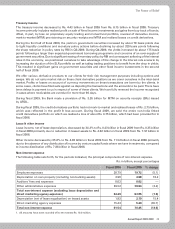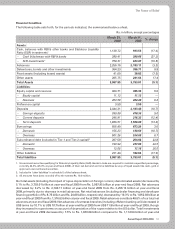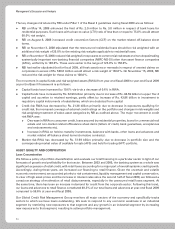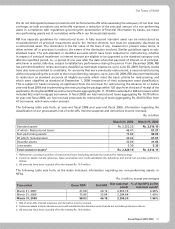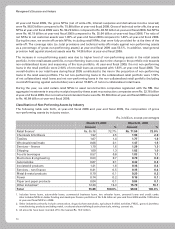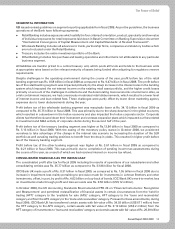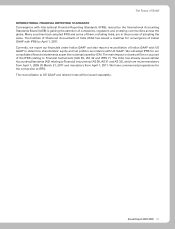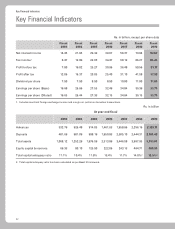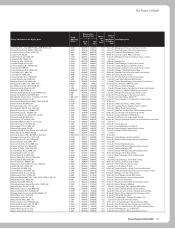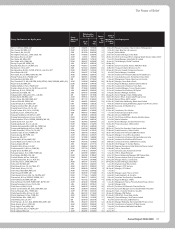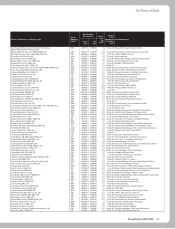ICICI Bank 2009 Annual Report Download - page 61
Download and view the complete annual report
Please find page 61 of the 2009 ICICI Bank annual report below. You can navigate through the pages in the report by either clicking on the pages listed below, or by using the keyword search tool below to find specific information within the annual report.
59Annual Report 2008-2009
The Power of Belief
SEGMENTAL INFORMATION
RBI issued revised guidelines on segment reporting applicable from fiscal 2008. As per the guidelines, the business
operations of the Bank have following segments:
Retail Banking includes exposures which satisfy the four criteria of orientation, product, granularity and low value
of individual exposures for retail exposures laid down in Basel Committee on Banking Supervision document
“International Convergence of Capital Measurement and Capital Standards: A Revised Framework”.
Wholesale Banking includes all advances to trusts, partnership firms, companies and statutory bodies which
are not included under the Retail Banking.
Treasury includes the entire investment portfolio of the Bank.
Other Banking includes hire purchase and leasing operations and other items not attributable to any particular
business segment.
All liabilities are transfer priced to a central treasury unit, which pools all funds and lends to the business units
at appropriate rates based on the relevant maturity of assets being funded after adjusting for regulatory reserve
requirements.
Despite challenges in the operating environment during the course of the year, profit before tax of the retail
banking segment was Rs. 0.58 billion in fiscal 2009 as compared to Rs. 9.47 billion in fiscal 2008. The profit before
tax of the retail banking segment was impacted primarily by the sharp increase in the interest rates in the banking
system which impacted the net interest income on the existing retail asset portfolio, and the higher credit losses
primarily on account of the challenges in collections and the deteriorating macroeconomic environment. Also, as
a risk containment measure, we had consciously moderated retail disbursements, which resulted in a lower level
of interest income and loan related fees. These challenges were partly offset by lower direct marketing agency
expenses due to lower disbursements during the year.
Profit before tax of the wholesale banking segment was marginally lower at Rs. 34.13 billion in fiscal 2009 as
compared to Rs. 35.75 billion in fiscal 2008. This was primarily due to the sharp downturn in the global economy
which resulted in a slowdown in the Indian economy and also impacted the Indian corporate sector. Corporate
clients had therefore slowed down their investment and overseas expansion plans which impacted our fees related
to investment and M&A activity of corporate clients during the second half of the year.
Profit before tax of the treasury banking segment was higher at Rs.12.84 billion in fiscal 2009 as compared to
Rs. 5.13 billion in fiscal 2008. With the easing of the monetary policy stance in October 2008, we positioned
ourselves to take advantage of the change in the interest rate scenario by increasing the duration of the SLR
portfolio as well as taking trading positions to benefit from the drop in yields. This resulted in higher profit before
tax of the treasury banking segment.
Profit before tax of the other banking segment was higher at Rs. 3.61 billion in fiscal 2009 as compared to
Rs. 0.21 billion in fiscal 2008. This was primarily due to completion of pending income tax assessments during
the course of the year, as a result of which we had received interest on income tax refund.
CONSOLIDATED FINANCIALS AS PER INDIAN GAAP
The consolidated profit after tax for fiscal 2009 including the results of operations of our subsidiaries and other
consolidating entities was Rs. 35.77 billion as compared to Rs. 33.98 billion for fiscal 2008.
ICICI Bank UK made a profit of Rs. 0.31 billion in fiscal 2009, as compared to Rs. 1.55 billion in fiscal 2008 due to
increase in impairment loss mainly pertaining to provision made for investments in Lehman Brothers and other
investments, offset, in part, by profit of Rs. 4.02 billion on buy-back of bonds. ICICI Bank UK’s mark-to-market loss
on investments made through profit and loss accounts was Rs. 0.56 billion (US$ 12 million).
In October 2008, the UK Accounting Standards Board amended FRS 26 on ‘Financial Instruments: Recognition
and Measurement’ and permitted reclassification of financial assets in certain circumstances from the ‘held for
trading (HFT)’ category to the ‘available for sale (AFS)’ category, HFT category to the ‘loans and receivables’
category and from the AFS category to the ‘loans and receivables’ category. Pursuant to these amendments, during
fiscal 2009, ICICI Bank UK has transferred certain assets with fair value of Rs. 34.03 billion (US$ 671 million) from
the HFT category to the AFS category, certain assets with fair value of Rs. 0.12 billion (US$ 2 million) from the
HFT category of investments to ‘loans and receivables’ category and certain assets with fair value of Rs. 20.39 billion


